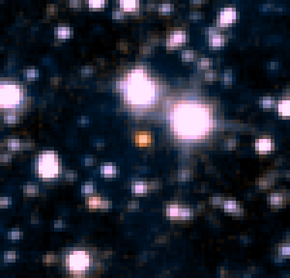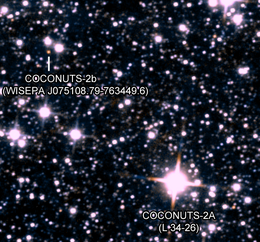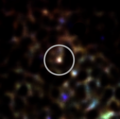
Brown dwarfs are substellar objects that have more mass than the biggest gas giant planets, but less than the least massive main-sequence stars. Their mass is approximately 13 to 80 times that of Jupiter (MJ)—not big enough to sustain nuclear fusion of ordinary hydrogen (1H) into helium in their cores, but massive enough to emit some light and heat from the fusion of deuterium (2H). The most massive ones can fuse lithium (7Li).
GJ 1061 is a red dwarf star located 12 light-years from Earth in the southern constellation of Horologium. Even though it is a relatively nearby star, it has an apparent visual magnitude of about 13, so it can only be seen with at least a moderately-sized telescope.

A subdwarf, sometimes denoted by "sd", is a star with luminosity class VI under the Yerkes spectral classification system. They are defined as stars with luminosity 1.5 to 2 magnitudes lower than that of main-sequence stars of the same spectral type. On a Hertzsprung–Russell diagram subdwarfs appear to lie below the main sequence.
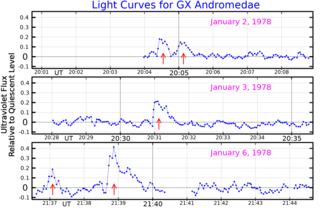
Groombridge 34 is a binary star system in the northern constellation of Andromeda. It was listed as entry number 34 in A Catalogue of Circumpolar Stars, published posthumously in 1838 by British astronomer Stephen Groombridge. Based upon parallax measurements taken by the Gaia spacecraft, the system is located about 11.6 light-years from the Sun. This positions the pair among the nearest stars to the Solar System.
TZ Arietis is a red dwarf in the northern constellation of Aries. With a normal apparent visual magnitude of 12.3, it is too faint to be seen by the naked eye, although it lies relatively close to the Sun at a distance of 14.6 light-years. It is a flare star, which means it can suddenly increase in brightness for short periods of time.
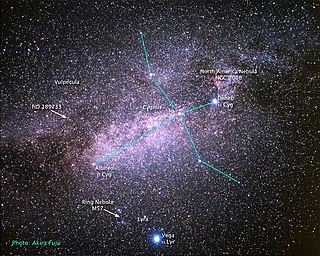
HD 189733, also catalogued as V452 Vulpeculae, is a binary star system 64.5 light-years away in the constellation of Vulpecula. The primary star is suspected to be an orange dwarf star, while the secondary star is a red dwarf star. Given that this system has the same visual magnitude as HD 209458, it promises much for the study of close transiting extrasolar planets. The star can be found with binoculars 0.3 degrees east of the Dumbbell Nebula (M27).

AD Leonis (Gliese 388) is a red dwarf star. It is located relatively near the Sun, at a distance of 16.2 light-years, in the constellation Leo. AD Leonis is a main sequence star with a spectral classification of M3.5V. It is a flare star that undergoes random increases in luminosity.

A sub-brown dwarf or planetary-mass brown dwarf is an astronomical object that formed in the same manner as stars and brown dwarfs but that has a planetary mass, therefore by definition below the limiting mass for thermonuclear fusion of deuterium . Some researchers call them rogue planets whereas others call them planetary-mass brown dwarfs. They are sometimes categorized as Y spectral class brown dwarfs.
HD 147506, also known as HAT-P-2 and formally named Hunor, is a magnitude 8.7 F8 dwarf star that is somewhat larger and hotter than the Sun. The star is approximately 419 light-years from Earth and is positioned near the keystone of Hercules. It is estimated to be 2 to 3 billion years old, towards the end of its main sequence life. There is one known transiting exoplanet, and a second planet not observed to transit.
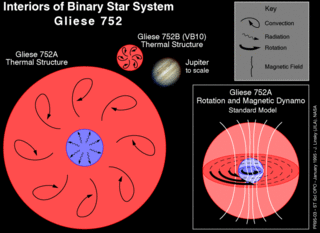
Gliese 752 is a binary star system in the Aquila constellation. This system is relatively nearby, at a distance of 19.3 light-years.

A planetary-mass object (PMO), planemo, or planetary body is, by geophysical definition of celestial objects, any celestial object massive enough to achieve hydrostatic equilibrium, but not enough to sustain core fusion like a star.
2MASS J21265040−8140293, also known as 2MASS J2126−8140, is an exoplanet orbiting the red dwarf TYC 9486-927-1, 111.4±0.3 light-years away from Earth. Its estimated mass, age, spectral type (L3), and Teff are similar to the well-studied planet β Pictoris b. With an estimated distance of around 1 trillion kilometres from its host star, it is one of the largest solar systems ever found.

LTT 1445 is a triple M-dwarf system 22.4 light-years distant in the constellation Eridanus. The primary LTT 1445 A hosts two exoplanets—one discovered in 2019 that transits the star every 5.36 days, and another found in 2021 that transits the star every 3.12 days, close to a 12:7 resonance. As of October 2022 it is the second closest transiting exoplanet system discovered, with the closest being HD 219134 bc.
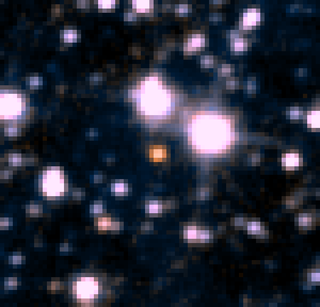
The COol Companions ON Ultrawide orbiTS (COCONUTS) program is a large-scale survey for wide-orbit planetary and substellar companions considered the first survey of this type of celestial bodies. In 2021, the team announced COCONUTS-2b, the closest exoplanet directly imaged ever. The program is a dedicated large-scale search for wide-orbit giant planets and brown dwarf companions, targeting a sample of 300,000 stars. By using multi-wavelength photometry and multi-epoch astrometry, astronomers are able to assess the candidates' companionship and ultracool nature.
